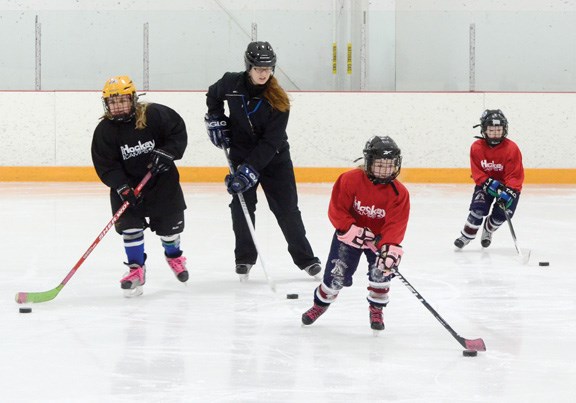Skating and shooting are two skills every hockey player should have. But in a fast and strategic game like ice hockey, it’s not an easy process to learn and synthesize the mechanics of those skills.
This Spring Break, instructors at Canlan Ice Sports are going to try to help young players break down their shots and improve on their weak points.
The week-long Girls Only Shooting & Scoring Camp will introduce players ages nine to 13 to the basic concepts of fundamental shots. It’s one of a number of hockey camps offered offered there this Spring Break.
“In hockey there are many different types of shots,” explains Whitney Juszkiewicz, hockey program co-ordinator at Canlan Ice Sports, who will be instructing the course.
The camp will focus primarily on skating, shooting and scoring, notes information from the club, but it will also include passing, receiving and conditioning. Juszkiewicz says it is best suited for players who already have some experience with skating and perhaps also with a house hockey league team.
During the camp, Juszkiewicz will analyze each individual player’s shooting and give them feedback, so that by the end of the camp they feel comfortable taking all kinds of different shots.
Each day, the players will progress to another technique that builds on the previous one they learned, notes Juszkiewicz.
Along with fundamental shooting techniques, players will also learn skating mechanics required for specific shots. They will learn how to pivot, throw their hips in the proper direction and understand the path they’re trying to get, says Juszkiewicz.
Once they understand and are comfortable with the footwork, game concepts are added, such as what to do when the puck is coming across the ice; where does the receiving player’s placement need to be and what should the player passing the puck be looking for.
One of the hardest parts of the game to learn is applying tenacity and energy to shots, notes Juszkiewicz. She explains that teaching the mechanics involves slowing down the moves and going over them step by step. That process tends to be somewhat passive, but hockey is a game of action.
“Hockey is such an explosive sport, it’s not passive,” says Juszkiewicz, adding that’s a hard part for a lot of kids to learn because they’re still trying to break down the mechanics of the game.
They end up doing the components right, but fall short on the final follow-through.
“It’s just like the pinball hammer, the gun hammer,” says Juszkiewicz of taking a shot. “When you initiate it, when you say ‘It’s time to shoot,’ you can’t really pull back. You have to go all in. Let it go. And if you make a bad shot, you make a bad shot, it happens.”
As an instructor, Juszkiewicz says she is very specific, tweaking even minor things like hand and stick rotation and finishing form.
“It really comes down to your communication process and reading the people you’re working with,” she says of coaching kids. “Every kid has their own story and they all have their own different developmental path and so it’s being able to read that and adjust to it.”
Juszkiewicz was a hockey player for about 13 years and played for Team Alberta. She left the sport for a while, but returned to it as an instructor. She also coaches with the North Vancouver Minor Hockey Association, and has been coaching their rep teams for two years. Juszkiewicz says she learned so much from hockey as a player and continues to learn from it as an instructor.
“When I was younger I got work ethic and I got team building. Now as I get older I learn accountability. It’s no longer just a coach pushing me,” she says.
“Through sports I found that I can really connect my mind and my body and really accomplish things in my life and drive forward.”
As an instructor, Juszkiewicz says she emphasizes sportsmanship, and training is not just hockey-specific, but involves a broader variety of skills.
“We really try to create athletes who happen to really like hockey,” explains Juszkiewicz.
This story originally appeared in our Kids Biz Spring Break feature.



